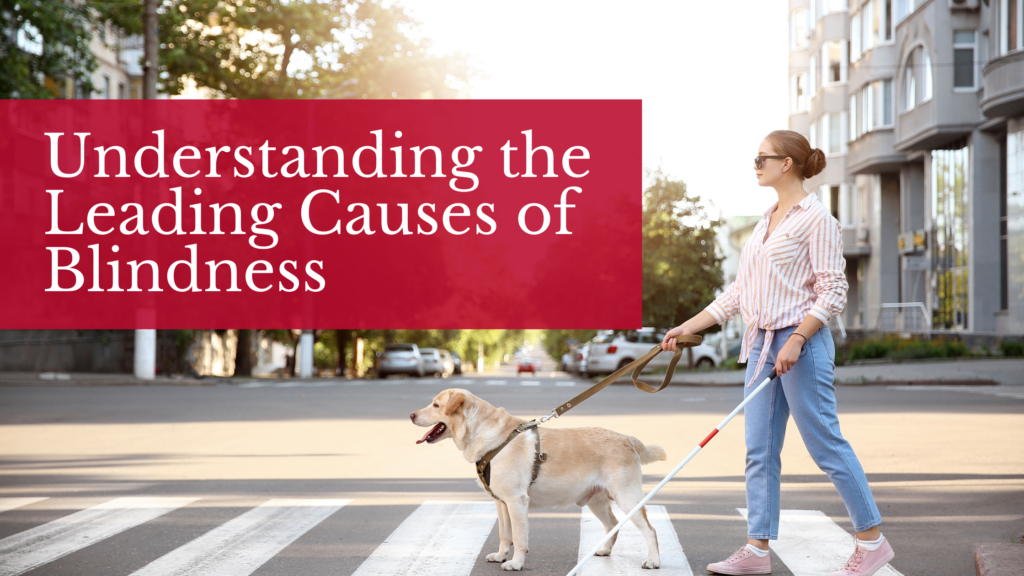October is Blindness Awareness Month. Across the world millions of people live with some form of vision loss. While total blindness affects a small percentage, many individuals experience low vision or visual impairment that significantly impacts their daily lives. Understanding the leading causes of blindness can help promote early detection and treatment, which is essential in preventing or managing vision loss.
What is Blindness?
Blindness refers to the complete loss of vision. In medical terms, total blindness means no light perception (NLP), where individuals cannot detect any light. However, many people with visual impairments retain some level of vision, even if it is limited or unclear.
Low Vision vs. Visual Impairment
- Low Vision: This refers to reduced vision that cannot be corrected with glasses, contact lenses, medication, or surgery. People with low vision may find it difficult to perform daily tasks like reading, recognizing faces, or driving.
- Visual Impairment: Visual impairment includes both low vision and blindness. It refers to any condition that significantly impacts a person’s ability to see and perform daily activities. The degree of impairment can vary widely, from mild to severe vision loss.
According to the World Health Organization, globally, at least 2.2 billion people have a near or distance vision impairment. In at least 1 billion of these, vision impairment could have been prevented or is yet to be addressed.
The Leading Causes of Blindness
There are several conditions that can lead to blindness or significant vision loss. Some of the most common causes include:
Cataracts
Cataracts are the leading cause of blindness worldwide. This condition occurs when the lens of the eye becomes cloudy, making vision blurry or dim. Cataracts typically develop slowly and are more common in older adults, but they can affect younger individuals as well. The good news is that cataracts can often be treated with surgery, where the cloudy lens is replaced with a clear artificial lens.
Age-Related Macular Degeneration (AMD)
Age-related macular degeneration (AMD) is the leading cause of blindness among people aged 65 and older. AMD affects the macula, a small part of the retina responsible for sharp, central vision. While AMD doesn’t cause complete blindness, it severely impairs central vision, making it difficult to see details clearly. Early diagnosis and treatments, such as injections or laser therapy, can slow down its progression.
Glaucoma
Glaucoma is another common cause of vision loss and is a condition that damages the optic nerve, often associated with high pressure inside the eye. Glaucoma usually progresses gradually and can go unnoticed in its early stages, making regular eye exams crucial for early detection. Without treatment, glaucoma can lead to irreversible vision loss, especially in peripheral vision.
Diabetic Retinopathy
Diabetic retinopathy is a complication of diabetes and a leading cause of blindness in adults between the ages of 25 and 64. People with diabetes are prone to damage of the blood vessels in the retina, causing them to leak fluid or bleed. This can lead to blurred vision or permanent vision loss if left untreated. Regular eye exams, managing blood sugar levels, and certain ocular therapies such as injections, laser, and surgery can help prevent diabetic retinopathy from worsening.
Uncorrected Refractive Errors
While not a direct cause of blindness, uncorrected refractive errors—such as nearsightedness, farsightedness, and astigmatism—are a major contributor to visual impairment. Fortunately, these conditions can be corrected with glasses, contact lenses, or refractive surgery. Ensuring access to eye care and vision correction is essential for maintaining good vision.
Who is Affected by Blindness?
Globally, an estimated 285 million people live with some form of visual impairment, including 39 million who are blind. The vast majority of those affected live in developing countries. Age is a significant factor, as more than 80% of those who are blind are aged 50 and older. In addition, women are at a higher risk of being visually impaired compared to men.
Prevention and Treatment
Approximately 80% of all visual impairments worldwide are preventable or treatable with timely medical care. Regular eye exams are crucial, especially for individuals over 50, those with a family history of eye disease, and people with diabetes. Early detection and treatment of conditions like cataracts, glaucoma, and diabetic retinopathy can prevent or slow vision loss.
In addition to medical treatment, low vision rehabilitation services can help individuals with visual impairments maximize their remaining vision and maintain independence.
Take Action for Blindness Awareness Month
This Blindness Awareness Month, take the time to prioritize your eye health. Schedule regular eye exams, learn the warning signs of common eye diseases, and encourage loved ones to do the same. Together, we can reduce the incidence of preventable blindness and improve the quality of life for those living with visual impairments.
For more information on eye health and resources for managing vision loss, speak to your eye care provider.

Read more from the National Institutes of Health
